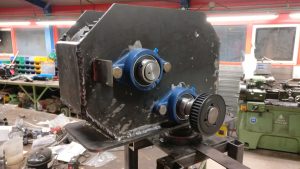Since the last post about the new windpump gearbox a lot of progress has been made. In this blog, we will discuss some of the findings during the process. Also, some important changes are made to the design which will be discussed. Starting from the last blog post about the gearbox the test installation is finalized from the first design.
Bearings
One of the first major changes to the design is the type of bearing used. At first normal bearings are used for which a housing is made and welded to the gearbox casing. As could be expected the alignment of the bearings was rather difficult. When the bearings were installed it was not possible anymore to change the distance between the two gears.

Both problems are solved by making use of flanged bearings which have a couple of advantages:
- Easy to replace.
- Axle can be fixed in place, so no additional parts are required.
- The ability to compensate for some misalignment.
First run
In the video below the first rotations of the gearbox are shown including the counting of the strokes. The transparant window is only for inspection purposes during the test phase of the gearbox.
Now all the main components are working the gearbox is painted and the last details are worked out such as preventing the weight from rotating during yawing.
Steel cable
At first a steel cable is used to transfer the rotating motion of the rotor into a translating motion. A 6mm thick steel cable is used, however this cable snapped after 59.535 strokes due to the small pully (60mm diameter) used to guide the cable. According to the steel cable manufacturer, a pully of a steel cable should have a minimum diameter of 20x the cable diameter. This would result in a pulley with a minimum diameter of 120mm, within the gearbox there is no space for such a pulley.
A smaller steel cable of 4mm in diameter is used in combination with a slightly larger pulley (85mm). This cable snapped after only 19.334 strokes, a final test is done with the 6mm cable in combination with the larger pulley. This helped a bit, however the cable still snapped after 69.591 strokes.
Another problem with the steel cable is that if the tension by the weight is released it will immediately ‘jump’ of the guide pulley. Whenever the gearbox is started after that the cable is damaged, which is not preferred if the gearbox is up a windpump.
Solution: Instead of the cable, a chain is used in the newest improvement of the gearbox. This new configuration has done over 120.000 strokes without problems.
Test results
Based on the previous blog post about the gearbox several things where tested and monitored during the manufacturing and working of the test setup:
- Effect of yawing on the cable: The weight is fixed and cannot rotate as we expect that the cable/chain will fail before the pump starts rotating in the borehole. Therefore a coupling is made which will account for the yawing motion of the windpump head. This connection can also be used as a safety feature if the pump will get stuck in the borehole for instance. –> this coupling is working well and will be discussed in a later blog.
- Ease of manufacturing: As discussed before, alignment of the bearings appeared to be difficult. With the new flanged bearings, the tolerances on the different shafts can be less precise.
- Oil consumption: Oil will leak through almost every hole present in the gearbox, so the correct type of seals have to be used where the axle goes through the gearbox housing and where the gearbox is bolted to the tower head. Most of the oil will leak via the cable/chain through the tower pipe if the cable/chain is touching the main gear. This can be easily prevented by making the gearbox housing a bit bigger.
- Failure modes: The main failure mode appeared to be the snapping of the cable, this is solved by using a chain instead of the cable. To find more failure modes the gearbox has to be tested with contamination like sand and water from outside the gearbox.
- Maximum load: The maximum load and the weight of the weight is not determined yet. It is assumed that the maximum load is currently limited by the motor simulating the rotor.

This is excellent work. We as Africans appreciate it. Helping to uplift us.